Designing and Building a Speaker Box Example
This example of a designing a speaker box makes use of many of the calculators found on this site. You should also review the Speaker Building Guide for additional help.
For this example, I picked 3 ScanSpeak drivers for a 3-way speaker - the same 3 used on the Crossover Tutorial. This design is old and the characteristics of these drivers have since changed and/or been discontinued. These 3 drivers might be smaller than what is expected of a typical 3-way system. The mid is 4" and the woofer is 6.5" in size, but this system is still capable of producing deep frequencies at 35Hz. The drivers I chose (with specifications provided by the manufacturer) are:
| Driver | Model | Size | Freq. Range | Imped. | Sensitivity | Xmax |
|---|---|---|---|---|---|---|
| Tweeter | D2008/8512 | 20mm | 2k-30k Hz | 8 ohms | 90 db SPL | |
| Mid | 13M/8636 | 4" | 200-4k Hz | 8 ohms | 88 db SPL | 1.5mm |
| Woofer | 18W/8543 | 6.5" | 35-3.2k Hz | 8 ohms | 89 db SPL | 6.5mm |
| Driver | Equivalent Volume (Vas) | Free Air Resonance (Fs) | Total Q (Qts) | Electrical Q (Qes) |
|---|---|---|---|---|
| Tweeter | 1000Hz | |||
| Mid | 3 liters | 77Hz | 0.32 | 0.36 |
| Woofer | 49 liters | 30Hz | 0.22 | 0.26 |
| Driver | Model | Size | Freq. Range | Imped. | Sensitivity | Xmax | Equivalent Volume (Vas) | Free Air Resonance (Fs) | Total Q (Qts) | Electrical Q (Qes) |
|---|---|---|---|---|---|---|---|---|---|---|
| Tweeter | D2008/8512 | 20mm | 2k-30k Hz | 8 ohms | 90 db SPL | 1000Hz | ||||
| Mid | 13M/8636 | 4" | 200-4k Hz | 8 ohms | 88 db SPL | 1.5mm | 3 liters | 77Hz | 0.32 | 0.36 |
| Woofer | 18W/8543 | 6.5" | 35-3.2k Hz | 8 ohms | 89 db SPL | 6.5mm | 49 liters | 30Hz | 0.22 | 0.26 |
We will first use the Sealed vs. Ported Speaker Box Calculator to determine if a sealed or a ported enclosure should be used. The Sealed vs. Ported calculator uses the formula below. If the EBP is less than 50, then a Sealed Enclosure is recommended. Above 90~100 and a Ported Enclosure is recommended. Between 50 & 90 either type would work.
Efficiency Bandwidth Product (EBP) = Free Air Resonance (Fs) / Driver Electrical "Q" (Qes)
The tweeter in our example is already sealed and doesn't require an enclosure. The EBP of our midrange and woofer drivers are calculated as:
Mid EBP = 77 / .36 = 213
Woofer EBP = 30 / .26 = 115
Both values are well above 90 and call for Ported Enclosures. To keep this example interesting, I am going to ignore these results and use one sealed enclosure and one ported enclosure to show the differences between the two.
A sealed chamber will be used for the mid and a ported enclosure for the woofer. Calculating box volume for a sealed box requires Vas, Fs, & Qts. We will use the standard .707 value for Qtc for a smooth roll-off at the low end. Calculating box volume and port size for a ported enclosure requires Vas, Fs, Qts, and the cone diameter.
To calculate the speaker box volume, we will use the Speaker Box Designer. We must remember to change to metric units in this calculator - all ScanSpeak numbers are in mm & liters. The sealed box midrange driver gives us:
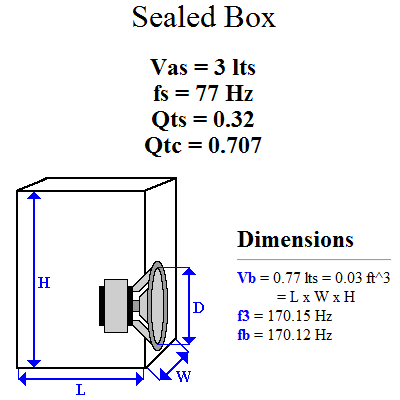
.03 cubic feet (0.77 liters) is an extremely small space for a speaker. Remember we should have been using a ported enclosure for this driver. The speaker itself is only 4" round. If we go with a minimum 4" x 4" box (the smallest the speaker will allow), then the box can only be about 3" deep - But I am of course ignoring the space taken up by the speaker itself and the internal bracing. Also, these are internal dimensions. The thickness of the wood will make the box larger.
ScanSpeak doesn't provide driver displacement information, so we will use the Driver Displacement Calculator. We will use the diagrams provided by ScanSpeak to enter numbers into our Displacement Calculator.
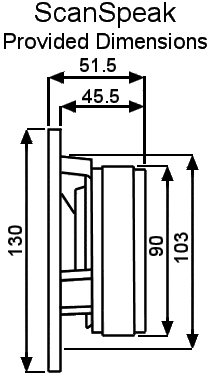
The Displacement Calculator is a best guess to the displacement of the speaker driver. It is not exact, but the more information you provide the better it will be. We will use 103mm as the cone diameter - not the 130mm diameter of the outer metal edge of the driver. Mounting depth is 45.5mm and magnet diameter is 90mm. Magnet height is not provided, so we measured a value of 30mm assuming this drawing is to scale. If we had the drivers in hand, then we could measure them to be sure. We also need to indicate that we will be flush mounting the driver and using 3/4" thick lumber in our enclosure.
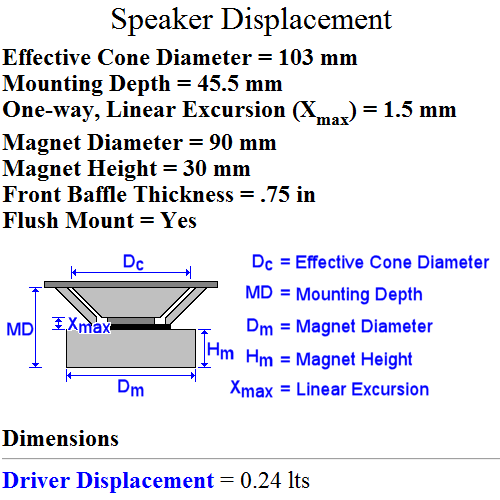
Now we are ready to use the Speaker Box Enclosure Volume Calculator to determine the outer dimensions of the speaker box. Also be sure to read the Help for the Speaker Box Calculator.
To use this calculator, we enter a speaker diameter of 4", the Box Volume (0.77 liters), Driver Displacement Volume (0.24 liters), Wood Thickness (3/4" - same as above), and indicate we will be using 3/4" battens. Now it is up to the user to adjust the width, height, and depth of the speaker box until the volume is .77 liters. The width and height of the box must be at least 4" to make room for the speaker itself. We are going to use 7" as the width here so that the same box width will also work for our 6.5" woofer.
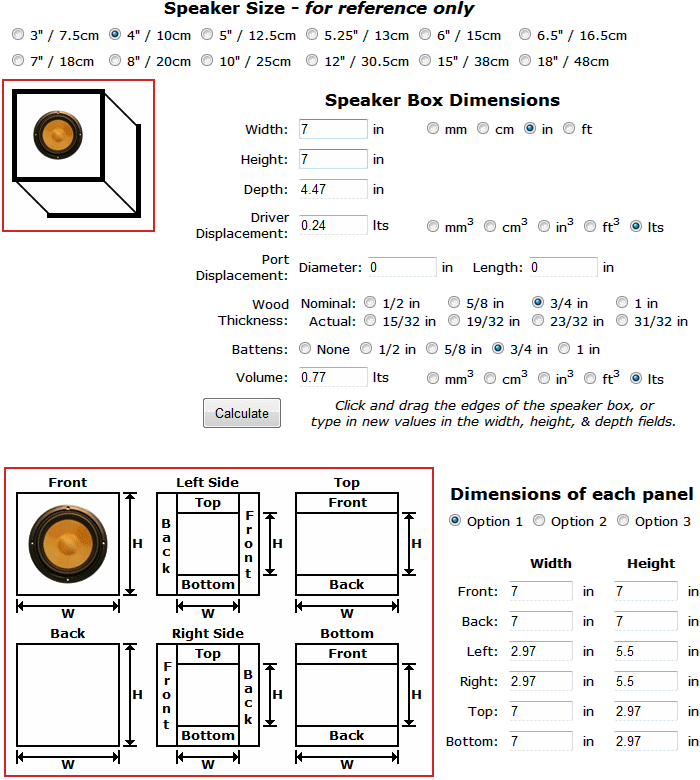
The Speaker Box Volume Calculator also provides the size of each panel of the box. We will not use this information as we will be building a single enclosure for all 3 drivers.
Now for the woofer. When using the ported speaker box calculator, the driver size (Effective Cone Diameter - D) is only used to determine port width. Using the Speaker Box Calculator for the ported box for the woofer gives us:
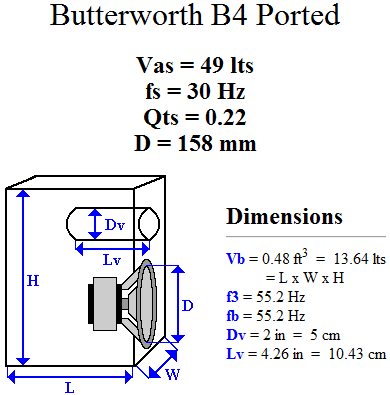
Our calculator gives us a .48ft3 enclosure with a 2" wide circular x 4.26" long port. Note: The port is given in both standard and metric units. These numbers are not the same. 2" = 5.08cm, not 5 cm exactly. The port length is calculated twice. Once for a port exactly 2" in diameter, and one for a port exactly 5cm in diameter. The assumption is that you will be purchasing an off the shelf port that only comes in nominal sizes.
Again, we don't have the woofer driver displacement, so we will use our calculator to estimate it. Here is the ScanSpeak diagram.
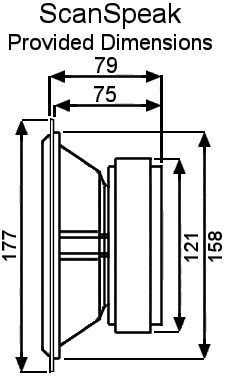
And here is the displacement calculator.
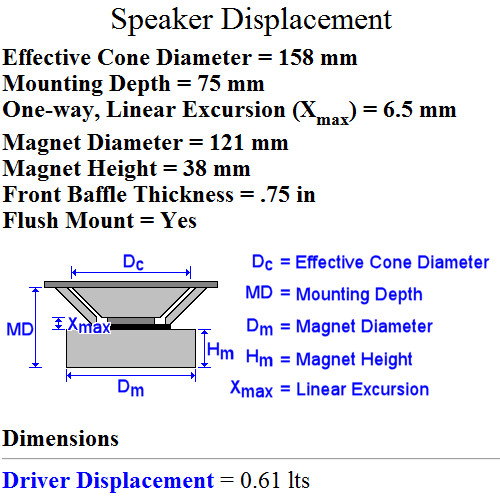
So we need a 13.64 liter box with a 2" diameter 4.26" long port and a 0.61 liter driver displacement. We want to keep the driver width the same 7" as the midrange speaker as above, so the additional volume will come from increasing the height and depth.
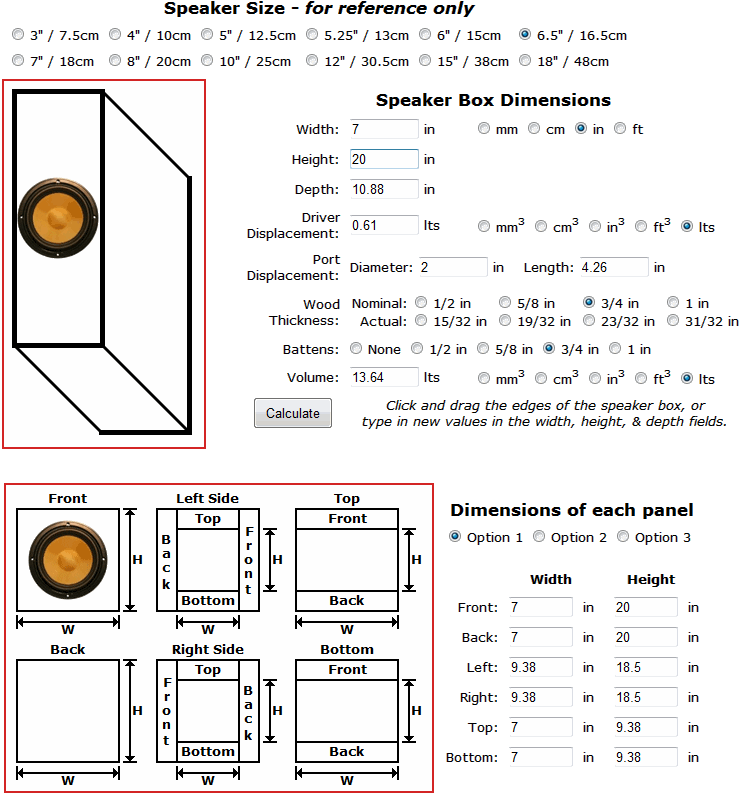
The next step is to decide on the general size and shape of the speaker box. Some possible options are shown below. The box volume for these drivers allow for a bookshelf style speaker, but for this example a floor standing speaker will be used instead. Note: It is not required to use the entire speaker box for the driver enclosure, so the outer dimensions of the speaker itself can be as large as desired.
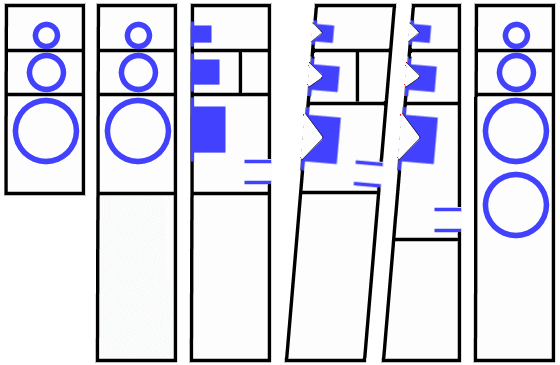
From left to right:
- A bookshelf speaker
- A floor standing speaker
- The side view of the same floor standing speaker. Note: the woofer will be ported in all of these design options, even when it isn't shown. Notice that the chamber for the midrange driver isn't the full depth of the speaker.
- Side view of an alternate design where the speaker is angled back. In an ideal speaker configuration, the back of each speaker cone lines up vertically. When flush mounted to a vertical piece of wood, the woofer will be a couple of inches behind the mid & tweeter.
- Another side view alternate configuration. In this design, only the front board is angled. The math in calculating chamber volume gets a little more complicated, but the build may get simpler with having only one angled side. There are also less balance problems. This design also leverages the fact that the top chambers are smaller (our midrange chamber needs to be small) so that the mid chamber can extend to the full depth of the speaker.
- In the final configuration there are two 6.5" woofers. Two woofers could be used to help with the fact that the woofers have lower power handling than the other drivers in this system and two woofers will also help in the low end frequencies. Adding a second driver doesn't simply mean you should double the box and port sizes. It might be a good starting point, but experimentation would be required to achieve the desired result. Without adequate testing equipment, you would be better off sticking to a simpler system unless you were following the published design from someone else. Searching online for DIY ScanSpeak 18W/8543 reveals several published designs using 1 or 2 of these drivers.
Some other thinks to consider:
- The box depth must be at least the port length + the port diameter - not really a problem for this system.
- Stay away from perfect cubes when determining speaker dimensions. The width, height and depth should not be the same value. It should be OK if 2 of the numbers are near the same value.
- Account for the size of the internal bracing and speaker driver displacement when determining the size of each chamber - again not a problem because our calculator does this for us.
- Account for the size of the crossover when determining the size of each chamber. Since this speaker has an unused chamber at the bottom the crossover will go there. This allows for changing/repairing the crossover without taking the speaker apart.
For some tips on the box construction, see the Speaker Building Guide.
For help in designing the crossover, see the Crossover Tutorial and Crossover Guide.